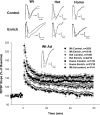Long-term enrichment enhances the cognitive behavior of the aging neurogranin null mice without affecting their hippocampal LTP
- PMID: 17671107
- PMCID: PMC1951789
- DOI: 10.1101/lm.636107
Long-term enrichment enhances the cognitive behavior of the aging neurogranin null mice without affecting their hippocampal LTP
Abstract
Neurogranin (Ng), a PKC substrate, is abundantly expressed in brain regions important for cognitive functions. Deletion of Ng caused severe deficits in spatial learning and LTP in the hippocampal CA1 region of mice. These Ng-/- mice also exhibit deficits in the amplification of their hippocampal signaling pathways critical for learning and memory. A short-term exposure to an enriched environment failed to improve their behavioral performances. Here, we showed that a long-term enrichment protocol for the aging mice was beneficial to the Ng-/- as well as Ng+/+ and Ng+/- mice in preventing age-related cognitive decline. Enrichment also caused an increase in the hippocampal CREB level of all three genotypes and Ng level of Ng+/+ and Ng+/- mice, but not that of alphaCaMKII or ERK. Interestingly, hippocampal slices of these enriched aging Ng-/- mice, unlike those of Ng+/+ and Ng+/- mice, did not show enhancement in the high frequency stimulation (HFS)-induced LTP in the CA1 region. It appears that the learning and memory processes in these enriched aging Ng-/- mice do not correlate with the HFS-induced LTP, which is facilitated by Ng. These results demonstrated that long-term enrichment for the aging Ng-/- mice may improve their cognitive function through an Ng-independent plasticity pathway.
Figures





Similar articles
-
Environmental enrichment enhances neurogranin expression and hippocampal learning and memory but fails to rescue the impairments of neurogranin null mutant mice.J Neurosci. 2006 Jun 7;26(23):6230-7. doi: 10.1523/JNEUROSCI.1182-06.2006. J Neurosci. 2006. PMID: 16763030 Free PMC article.
-
Age-related deficits in long-term potentiation are insensitive to hydrogen peroxide: coincidence with enhanced autophosphorylation of Ca2+/calmodulin-dependent protein kinase II.J Neurosci Res. 2002 Nov 1;70(3):298-308. doi: 10.1002/jnr.10427. J Neurosci Res. 2002. PMID: 12391589
-
Environmental enrichment modifies the PKA-dependence of hippocampal LTP and improves hippocampus-dependent memory.Learn Mem. 2001 Jan-Feb;8(1):26-34. doi: 10.1101/lm.36301. Learn Mem. 2001. PMID: 11160761 Free PMC article.
-
Long-term potentiation and the ageing brain.Philos Trans R Soc Lond B Biol Sci. 2003 Apr 29;358(1432):765-72. doi: 10.1098/rstb.2002.1244. Philos Trans R Soc Lond B Biol Sci. 2003. PMID: 12740124 Free PMC article. Review.
-
Long-term potentiation and synaptic protein phosphorylation.Behav Brain Res. 1995 Jan 23;66(1-2):53-9. doi: 10.1016/0166-4328(94)00124-x. Behav Brain Res. 1995. PMID: 7755899 Review.
Cited by
-
Impact of the genome wide supported NRGN gene on anterior cingulate morphology in schizophrenia.PLoS One. 2012;7(1):e29780. doi: 10.1371/journal.pone.0029780. Epub 2012 Jan 12. PLoS One. 2012. PMID: 22253779 Free PMC article.
-
Neurobehavioral Effects of Restricted and Unpredictable Environmental Enrichment in Rats.Front Pharmacol. 2020 May 12;11:674. doi: 10.3389/fphar.2020.00674. eCollection 2020. Front Pharmacol. 2020. PMID: 32477137 Free PMC article.
-
Chronic enhancement of CREB activity in the hippocampus interferes with the retrieval of spatial information.Learn Mem. 2009 Feb 23;16(3):198-209. doi: 10.1101/lm.1220309. Print 2009 Mar. Learn Mem. 2009. PMID: 19237642 Free PMC article.
-
Concise review: the promise of human induced pluripotent stem cell-based studies of schizophrenia.Stem Cells. 2011 Dec;29(12):1915-22. doi: 10.1002/stem.762. Stem Cells. 2011. PMID: 22009633 Free PMC article. Review.
-
Implementation of environmental enrichment after middle age promotes healthy aging.Aging (Albany NY). 2018 Jul 20;10(7):1698-1721. doi: 10.18632/aging.101502. Aging (Albany NY). 2018. PMID: 30036185 Free PMC article.
References
-
- Arendash G.W., Garcia M.F., Costa D.A., Cracchiolo J.R., Wefes I.M., Potter H. Environmental enrichment improves cognition in aged Alzheimer’s transgenic mice despite stable β-amyloid deposition. Neuroreport. 2004;15:1751–1754. - PubMed
-
- Bach M.E., Barad M., Son H., Zhuo M., Lu Y.F., Shih R., Mansuy I., Hawkins R.D., Kandel E.R. Age-related defects in spatial memory are correlated with defects in the late phase of hippocampal long-term potentiation in vitro and are attenuated by drugs that enhance the cAMP signaling pathway. Proc. Natl. Acad. Sci. 1999;96:5280–5285. - PMC - PubMed
-
- Bennett J.C., McRae P.A., Levy L.J., Frick K.M. Long-term continuous, but not daily, environmental enrichment reduces spatial memory decline in aged male mice. Neurobiol. Learn. Mem. 2006;85:139–152. - PubMed
Publication types
MeSH terms
Substances
Grants and funding
LinkOut - more resources
Full Text Sources
Medical
Molecular Biology Databases
Miscellaneous
